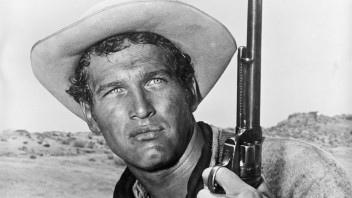DIRECTED BY ARTHUR PENN
HARROLL PRODUCTIONS
WARNER BROS.

INFORMATION FROM IMDb
Plot Summary
William Bonney - Billy the Kid - gets a job with a cattleman known as 'The Englishman,' and is befriended by the peaceful, religious man. But when a crooked sheriff and his men murder the Englishman because he plans to supply the local Army fort with his beef, Billy decides to avenge the death by killing the four men responsible, throwing the lives of everyone around him - Tom and Charlie, two hands he worked with; Pat Garrett, who is about to be married; and the kindly Mexican couple who take him in when he's in trouble - into turmoil, and endangering the General Amnesty set up by Governor Wallace to bring peace to the New Mexico Territory.
Written by Gary Dickerson
Cast
Paul Newman ... Billy The Kid
Lita Milan ... Celsa
John Dehner ... Pat Garrett
Hurd Hatfield ... Moultrie
James Congdon ... Charlie Boudre
James Best ... Tom Folliard
Colin Keith-Johnston ... Tunstall
John Dierkes ... McSween
Robert Anderson ... Hill (as Bob Anderson)
Wally Brown ... Deputy Moon
Ainslie Pryor ... Joe Grant
Martin Garralaga ... Saval
Denver Pyle ... Ollinger
Paul Smith ... Smith
Nestor Paiva ... Pete Maxwell
Jo Summers ... Bride
Robert Foulk ... Sheriff Brady
Anne Barton ... Mrs. Hill
Boyd 'Red' Morgan ... Soldier (uncredited)
and many more...
Directed
Arthur Penn
Writing Credits
Leslie Stevens ... (screenplay)
Gore Vidal ... (play)
Produced
Fred Coe ... producer
Music
Alexander Courage
Cinematography
J. Peverell Marley
Trivia
Paul Newman was widely felt to be miscast as Billy the Kid since at 33 he was considerably older than the character. Billy was supposed to be 18 at the beginning of the film.
The movie was a flop at the US box office.
The film originally was to have been made in 1956 with James Dean in the lead role.
Interestingly, the title of this movie promotes a common misconception that was proved untrue in 1986. Two almost identical tintypes of Billy the Kid were taken at the same time in 1880. The original of one tintype disappeared years ago. The second original tintype was preserved for years in the Sam Diedrick family and came to light only in 1986. Since tintypes are reversed images, the picture from the first tintype led to the myth of the left-handed gun. After the second tintype came to light, the reversed image was reversed to show the Kid as he actually posed, with a Winchester carbine in the left hand and his holstered Colt single-action on his right hip. See Utley, Robert M., Billy the Kid, A Short and Violent Life, University of Nebraska Press, 1989. Statement following page 110 alongside the picture of Billy the Kid.
The character of "Tunstall" was based on a real person, John Henry Tunstall, an English immigrant who was murdered in 1878, aged 24 or 25 at time of death, under circumstances very similar to those portrayed in this film. However, in this, and every other film in which there's a portrayal of "Tunstall" [this film], "Henry Tunstall" [Chisum (1970)], or "John Tunstall" [Young Guns (1988)], not only is a different version of Tunstall's name used, but the actors portraying the Tunstall character have been double (or more) the age of the real life Tunstall at the time of his death. At the time of production of this film, Colin Keith-Johnston was approximately 61 years old; at the time of production of Chisum, Patric Knowles was approximately 58 years old; and at the time of production of Young Guns, Terence Stamp was approximately 49 years old.
The sets for the town of Medaro were actually left over from Warners' 1939 epic Juarez (1939). Although they were in state of great disrepair, parts of them were salvaged for use in "The Left-Handed Gun."
Cinematic directorial debut of Arthur Penn.
Gore Vidal greatly disliked this well-received film version of his television play, "The Death Of Billy The Kid", once describing it as "a film only someone French could like." He was greatly annoyed when director Arthur Penn expressed criticisms of his original script and brought in Leslie Stevens for rewrites. In 1990, the TV movie "Billy The Kid" was made, not only as a remake of this film, but as a rebuttal of it, written and largely controlled by Vidal himself. He declared himself pleased with it, but the 1958 film remains better-known.
Warner Bros. reportedly interfered with the production and would not allow Penn to shoot the ending he wanted. In addition, the director was cut out of the editing process.
First film for producer Fred Coe.
Shot in only 23 days.
Goofs
Factual errors
The film is about western outlaw Billy the Kid, who was in fact right-handed.
The "Englishman" describes his origins as from Ayrshire, a county in South West Scotland. In that case he would be a Scot and not English.
Miscellaneous
Billy and the others are at a lake. You see the reflection of the moon in the water. One of them shouts "the moon" and they start shooting the reflection of the moon. When the camera zooms out, you see Billy and his pals are facing the camera, so the moon was in their back all the time. Hence there couldn't have been a reflection of the moon.
Memorable Quota
Filming Locations
Columbia/Warner Bros. Ranch - 411 North Hollywood Way, Burbank, California, USA
Laramie Street, Warner Brothers Burbank Studios - 4000 Warner Boulevard, Burbank, California, USA
Stage 2,27,27A,28,28A Warner Brothers Burbank Studios - 4000 Warner Boulevard, Burbank, California, USA
Watch the Movie
[extendedmedia]
[/extendedmedia]


